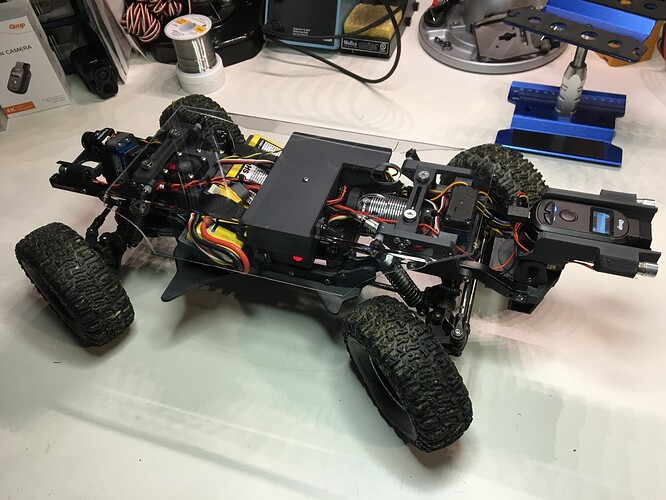Finishing up some details on the latest Ferret model. She’s sporting a few new options as compared to the Mk2 run from last year. Huge delays due to medical issues. But, the first one goes to one of my development guys next week for fun and abuse.
The angled armor plate published in September 2020 made it onto this one. The plate pictured is clear, but will be bronze /smoked in production units. Lexan. Unbreakable. The reason for a smoked plate is to hide scratches, while allowing the innards to be visible. The reviewer team and I thought this would be best. There is no reason to remove the plate in the course of normal operations, so visibility is nice to have.
The motor is a closed-can, FOC unit. A sealed motor rejects dust, debris and water. Open-can motors may pull these inside with their fans, and even pass the foreign matter into the spur gear area. Basically, zero maintenance. The FOC option is one where the speed of the rover is constant, via real time automatic torque adjustment, and will keep it moving regardless of the terrain. When a normal rover encounters an obstacle to the wheel at slow speed, it will slow, or stop, until more throttle is applied. This can result in an unpredictable bump in speed once the obstacle is defeated, and place the rover where you don’t want it. Think pipe-and-pit, or launching into a wall. FOC allows the operator to literally creep at insanely slow speeds with no hair trigger throttle management. Creeping up the top of a pipe to get a good look at what’s beyond is easy, without riding the throttle, or fear of rolling over it.
The 4WS we offered in April 2019 remains, but is enhanced by the addition of 2WS. This is selectable via a toggle switch on the controller. By using the rear axle trim knob, the Mk3 is capable of crab steering, as well. “Select Steer” gives advanced operators two more means of maneuvering in truly garbage situations. The rear backup camera remains as standard, also. After transiting 15’ of tight junkyard debris, who wants to try to remember what lies behind, and cross it in reverse, blindly?
Lighting is “switched up”, literally. Lights are on/off switchable. We’ve also moved away from vertical strip lights and into coaxially mounted spots. The foot candle testing we ran showed comparable output at lower power levels. The lights are easily replaceable in the field - within seconds. These also remove two entanglement points from the front of the rover.
One item present on the Mk1 and Mk2 was a means of vertical deployment. Unless I’ve missed it somewhere, I’m not aware of any rover that can be safely and easily lowered into a deep hole single handed. If you have to go prone and stretch to the limits of your reach to deploy, or retrieve with one hand, some means of grasping the machine is needed - one that doesn’t drop it on the ground with damage to camera or other bits. Mk3 incorporates a grip that lets the operator lower it at a nose-up angle. The rear most parts of the rover are the tires. No damage there. Set it down on those, lower the front tires to the ground, and she’s good. This also reduces the fore /aft dimension enabling tight deployment.
Numerous other changes make the Ferret Mk3 a capable, unified integration of systems that compliment each other. While individual advancements are nice, it is useful integration that makes for a nice package.
Until I have settled on a proper Pelican case for it, or similar, I will be making these available in Central California. I don’t trust shipping companies much. I’d like to help out nation-wide after the first of the year.
I’ll have a site up soon with details.

